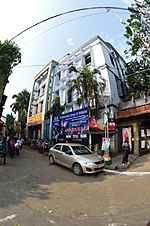West Bengal (, Bengali: Poshchim Bongo, pronounced [ˈpoʃtʃim ˈbɔŋɡo] (listen), abbr. WB) is a state in the eastern portion of India. It is situated along the Bay of Bengal, along with a population of over 91 million inhabitants within an area of 88,752 km2 (34,267 sq mi). West Bengal is the fourth-most populous and thirteenth-largest state by area in India, as well as the eighth-most populous country subdivision of the world. As a part of the Bengal region of the Indian subcontinent, it borders Bangladesh in the east, and Nepal and Bhutan in the north. It also borders the Indian states of Odisha, Jharkhand, Bihar, Sikkim and Assam. The state capital is Kolkata, the third-largest metropolis, and seventh largest city by population in India. West Bengal includes the Darjeeling Himalayan hill region, the Ganges delta, the Rarh region, the coastal Sundarbans and the Bay of Bengal. The state's main ethnic group are the Bengalis, with the Bengali Hindus forming the demographic majority.
The area's early history featured a succession of Indian empires, internal squabbling, and a tussle between Hinduism and Buddhism for dominance. Ancient Bengal was the site of several major Janapadas, while the earliest cities date back to the Vedic period. The region was part of several ancient pan−Indian empires, including the Vangas, Mauryans, and the Guptas. The citadel of Gauḍa served as the capital of the Gauḍa Kingdom, the Pala Empire, and the Sena Empire. Islam was introduced through trade with the Abbasid Caliphate, but following the Ghurid conquests led by Bakhtiyar Khalji and the establishment of the Delhi Sultanate, the Muslim faith spread across the entire Bengal region. During the Bengal Sultanate, the territory was a major trading nation in the world, and was often referred by the Europeans as the "richest country to trade with". It was absorbed into the Mughal Empire in 1576. Simultaneously, some parts of the region were ruled by several Hindu states, and Baro-Bhuyan landlords, and part of it was briefly overrun by the Suri Empire. Following the death of Emperor Aurangzeb in the early 1700s, the proto-industrialised Mughal Bengal became a semi-independent state under the Nawabs of Bengal, and showed signs of the first Industrial revolution. The region was later conquered by the British East India Company at the Battle of Plassey in 1757 and became part of the Bengal Presidency. From 1772 to 1911, Calcutta was the capital of British India. From 1912 to India's Independence in 1947, it was the capital of all of Bengal.
The region was a hotbed of the Indian independence movement and has remained one of India's great artistic and intellectual centres. Following widespread religious violence, the Bengal Legislative Council and the Bengal Legislative Assembly voted on the Partition of Bengal in 1947 along religious lines into two independent dominions: West Bengal, a Hindu-majority Indian state, and East Bengal, a Muslim-majority province of Pakistan which later became the independent Bangladesh. The early and prolonged exposure to British administration resulted in an expansion of Western education, culminating in developments in science, institutional education, and social reforms in the region, including what became known as the Bengali Renaissance. Several regional and pan−Indian empires throughout Bengal's history have shaped its culture, cuisine, and architecture.
Post-Indian independence, as a welfare state, West Bengal's economy is based on agricultural production and small and medium-sized enterprises. The state's cultural heritage, besides varied folk traditions, ranges from stalwarts in literature including Nobel-laureate Rabindranath Tagore to scores of musicians, film-makers and artists. For several decades, the state underwent political violence and economic stagnation before it rebounded. In 2021–22, the economy of West Bengal is the sixth-largest state economy in India with a gross state domestic product (GSDP) of ₹15.36 lakh crore (US$190 billion), and has the country's 20th-highest GSDP per capita of ₹121,267 (US$1,500). Despite being one of the fastest-growing major economies, West Bengal has struggled to attract foreign direct investment due to adverse land acquisition policies, poor infrastructure, and red tape. In India, the state is ranked ninth for both ease of doing business and media exposure. West Bengal performs poorly in terms of lowering the poverty rate, with 14.88% of the population living below the national poverty rate. While the state performs poorly in terms of the rate of school enrollment and has high human trafficking incidences, it scores quite highly in terms of child nutrition, women's safety, and the literacy rate. It also has the 28th-highest ranking among Indian states in human development index, with the index value being lower than the Indian average. The state government debt of ₹5.2 lakh crore (US$65 billion), or 34.41% of GSDP, is fifth highest India, but has dropped from 40.65% since 2010–11. There is moderate unemployment. West Bengal has two World Heritage sites and ranks as the seventh-most visited tourist destination in India.






